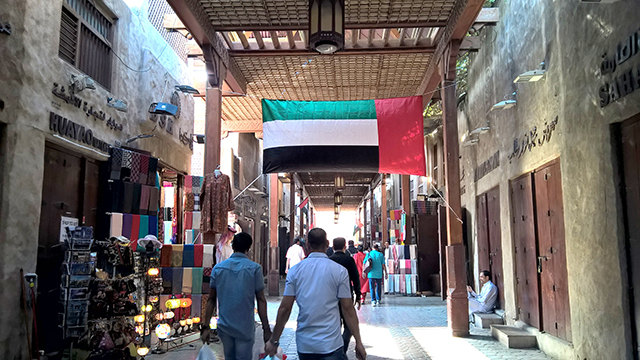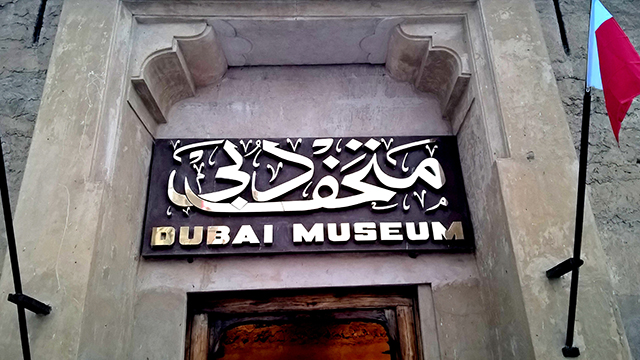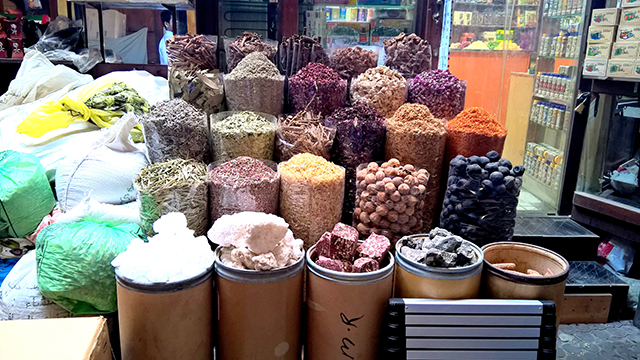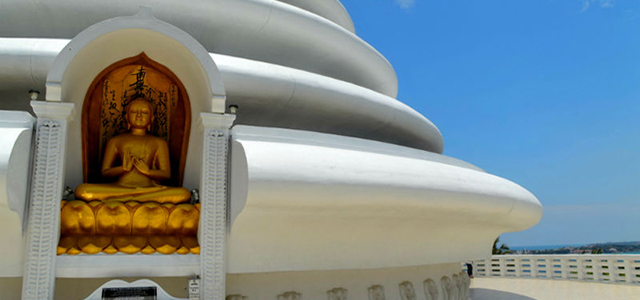
Exploring Art and Culture in Dubai
Posted on March 14, 2016 by Manjulika Pramod & filed under Travel
Three years ago when I visited Dubai for the first time, I was not so impressed with it. I thought the place was only enamored by the dazzle and fizz of the world’s highest, biggest and largest. But in my recent visit to the Emirate, I came back with an entirely different perception. I was taken in for a surprise when I explored it beyond its skyscrapers and lavish settings. I ensured that I kept away from the glitz and glamour and walked through its historical neighborhoods. This experience not only introduced me to its bygone eras but it also helped me find the gems of the Emirate that are high on art, culture and heritage.

We all know that Dubai is an attractive tourist destination but do we really know that it was a small fishing village that was born around the creek. It has undergone a beautiful transformation but the best part is that the metropolis Emirate has yet not forgotten about its humble beginnings. The historical elements shine in its Bedouin culture, ancient artifacts, heritage neighborhoods, wind towers, museums and more. If you walk around the Creek and Old Dubai, the roots of modern Dubai can be easily traced back to the times when its people only knew fishing and pearl diving for a living. And it is there that you realize that modern Dubai was not born in a day, but that it has a rather beautiful past.
While I was searching for the real and authentic Dubai, my hotel apartment near Al Fahidi metro station came as a plus. Situated at the edge of Old Dubai, it really helped me to discover a part of Dubai that wasn’t all about new construction, high-rise buildings or the high-end malls. I was able to explore Old Dubai in its skin and character. And I bet that it is the place to be if you really wish to soak in the warmth of the unpretentious and the original Emirati culture. The art, architecture, dining, music and nightlife are unique to this part of the Emirate. The abras and dhows, the souqs and the small shops, men in dishdashas and women dressed in abayas will bring you closer to its culture.
To really explore the culture I started at the Dubai Museum. It is located in the oldest fort of Dubai in the Al Fahidi fort, which dates back to 1787. The museum offers important insights into the history and development of the city. One does not get tired walking in there because it is a small museum, but what you learn inside is quite valuable. The collection of artifacts tells us the story of Dubai’s evolution in the last few decades.

The art scene at Bastakiah (Al Fahidi Historical Neighborhood) is vibrant and flourishing. The sand colored houses, wooden doors, intricate carvings, elaborate arches and wind towers alone merit a visit to this area. Both traditional and contemporary art their place here. The labyrinthine lanes of the Bastakiya quarters are fascinating. The beautiful wind towers and the narrow meandering lanes made me curious at every turn. Initially, this neighborhood was inhabited by pearl and textile merchants from Iran and thus it was named after the Iranian town, Bastak. This artsy place has been restored well to give us a glimpse of the old buildings, structures and city’s unique charm. And one just can’t miss the small museums, art galleries, souvenir shops and artsy cafes here.
Dubai water taxis play a great role in taking us from one side (Bur Dubai) side to another (Deira). The Abra ride is great fun. It just costs Dhs1 to cross Bur Dubai and be lost in the shopping world of Deira. Once you are on the other side of the creek, you must be prepared for a different impression of Dubai. Different souks are located in Deira. The scents, sights and sounds at the spice souq are absolutely fascinating. Next to it is the famous gold souk which has nearly 800 gold shops is one of largest gold retail markets in the world.

To explore Dubai’s past and its Bedouin life, I also visited the famous Heritage Village at the Al Shindaga waterfront. The village recreates a picture of the past times. Here, one can drink Arabic tea, eat local delicacies, buy at the craft stalls and enjoy camel rides. A visit to this place also helps to peep into the local Emirati culture.
While exploring the art and culture of Dubai, one really can’t miss a visit to the Sheikh Saaed bin Maktoum’s house. This is a house of importance because this was his home from 1912-1958. In fact, the present ruler of Dubai has lived and played inside the premises of the house. It is famous for its design and style of construction. It holds many important historic photographs of the sheikhs, their past and life in Dubai. The collection in the house takes us through the journey of transformation that Dubai has undergone in the last few decades.
Dubai has always heightened my love for the man-made but now I can gladly say that it is not just about them. The urban architecture has definitely made it a famous tourist destination but it knows the importance of safeguarding its past.
Main Image Photo Credit: © iStock/DTatiana8
About the Author: The engineer in me has quit the high salaried job of 8 years and is happily living a life of an independent blogger, freelance content writer and a social media enthusiast. My heart and soul lies in reading, writing, traveling, talking and blogging.




